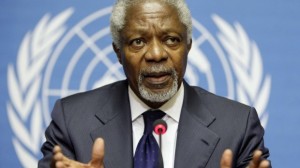Feasible or Impossible?

according to former UN Secretary General Kofi Annan.
Photo credit: Robin Westenra
During the past decade there have been significant developments in the field of international environmental law due to the factual understanding that environmental issues transcend national borders and legal systems. However, the scientific uncertainty about the long‐term effects of international environmental risks often allows nations to justify postponing compliance with international environmental law.
Nonetheless, examples of environmental damage are inarguably real; they include acid rain, biological diversity loss, endangered habitats and species protection, environmental disasters, global climate change, global environmental markets, hazardous waste management, ozone depletion, and unsustainable development.
Is it increasingly feasible that states could be regulated by other states for causing climate change overseas? Should lawsuits based on constitutional rights to a healthy environment, strict liability for environmental harm, or any number of other legal principles exist?
Richer and industrialized nations have contributed largely to environmental damage, which poorer, smaller, and underdeveloped countries will have to cope with, despite having fewer resources to do so. Environmental Disasters Professor Harris Ali at York University calls this the “free-rider” problem. The free-rider dilemma hinges upon the collective nature of environmental problems, “free-riders” refer to states that will not implement environmental protective measures and continue to pollute—causing harm to the common and shared space of our Earth. “The person producing the pollution is not responsible for paying the environmental costs associated with the pollution; so they are getting a free ride,” says Professor Ali.
This has been the driving force for the creation of regulations and treaties such as the Kyoto Protocol and the Montreal Protocol. Countries such as India, China, and the United States have been hesitant to sign the Kyoto Protocol, a treaty which seeks to regulate world-wide carbon dioxide emissions.
This is the ultimate tragedy of commons in environmental law—where there is no authoritative body that has the jurisdiction to regulate, monitor, and enforce environmental policy in different sovereign nations. Furthermore, Professor Ali argues that there are conflicting interests between politics and economics. Countries may be hesitant to implement environmental policies that would affect their industries and costs of production. “The state is always caught in a catch-22 situation, because they need industry to get the money to do what they want to do and votes from the people,” he says; “they are always walking a delicate balance and in the end the environment is sacrificed.”
In recent history there have been some success in at least one area of international law governing the regulation of environmental pollution. The Montreal Protocol, which called upon sovereign states to end the production and utilization of chlorofluorocarbons (CFCs) is an example that international law can sustain environmental protection.
Recently, Canada’s Environment Minister Leona Aglukkaq announced that Canada plans to reduce its greenhouse gas (GHG) emissions by 30% below 2005 levels by 2030 through regulatory actions.
Canada’s ambitious target is much like those of other major industrialized countries and this target was submitted to the United Nations Framework Convention on Climate Change this summer.

But this raises questions about how much of an impact such regulations will make on Canada’s “climate debt.” Climate debt refers to a state’s excessive use of a shared atmosphere and climate system, requiring poorer states to pay to mitigate a crisis they did little to cause (an emissions debt), and the damages and costs caused by climate change, requiring poorer states to adapt to the negative effects (an adaptation debt).
This is precisely why there should be a policy of monitoring and publicizing violations of international environmental law. Disclosure of informational policy focused on elucidating environmental violations would be more cost effective than enforcement. Mary Ellen O’Connell, Research Professor of International Dispute Resolution, argues in Enforcement and the Success of International Environmental Law that environmental law is “less well-suited to enforcement that other areas of international law.”
Damon Matthews, a researcher at the Concordia University in Montreal, recently published a study in Nature Climate Change, where he attempts to quantify the amount of climate debt different nations owe to our planet.
Matthews says the United States has benefited economically from polluting the global environment and the costs are experienced by countries across the globe. Even though China has a bad reputation for carbon emissions due to being one of the world’s biggest production giants, Matthews argues that the United States is largely responsible for emitting huge amounts of carbon. He estimates that the “United States is a clear leader among debtor countries, with historical CO2 emissions that have consistently exceeded the world per-capita average.”
However, the United States is also among several countries that have donated money to the UN Green Climate Fund (GCF) —to help with the cost of climate adaptation and damages in vulnerable countries. Though critics argue the funding—valued at approximately ten billion dollars—does not cover the immense damage caused by environmental pollution, the Green Fund is a seemingly positive step in the right direction for international environmental law.
The UNGCF was created as a financial tool of the UN Framework Convention on Climate Change (UNFCCC) in 2011. Its role is to make financial contributions to attaining the environmental mitigation and adaptation goals of the international community in developing countries.
Furthermore, the recently successful Dutch class action emissions case is a significant step forward in a nation’s legal recognition of policing emission targets. Dutch Law firm Pulussen Advocaten used the research of the Intergovernmental Panel on Climate Change (IPCC) as evidence. IPCC is a group of scientists, supported by the UN, which urged all countries to meet specific emissions targets to help fight global warming.
The Dutch emissions case win in court, coupled with the implementation of the UN’s GFC fund, signifies a strong recognition of the costs of climate debt, and an attempt by the international community to control environmental damage before it’s too late.
